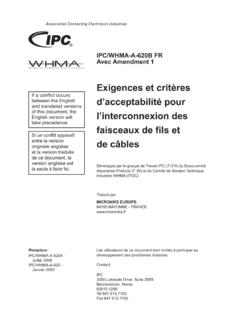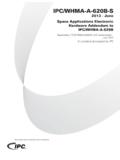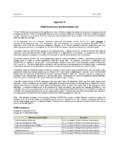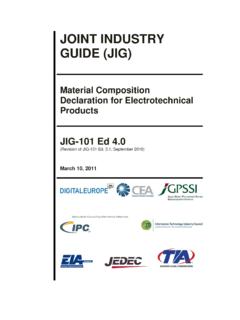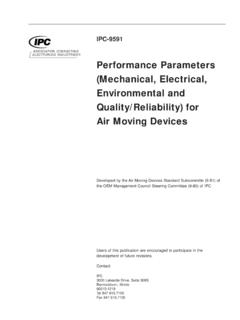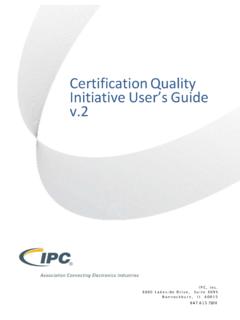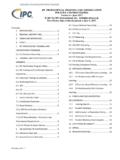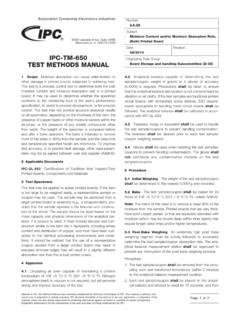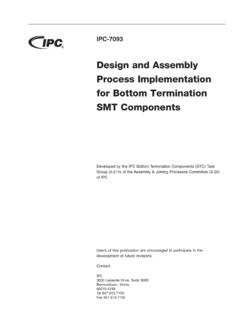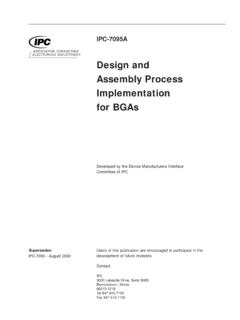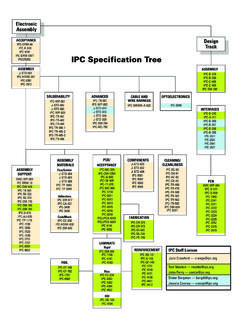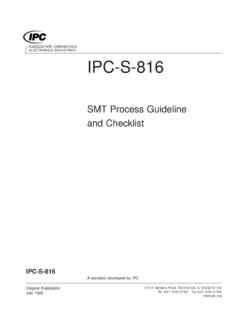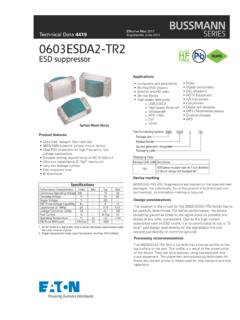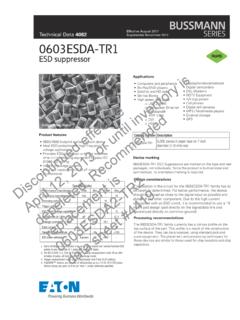Transcription of and Application of Underfill Material for Flip Chip …
1 IPC J-STD-030 Guideline for Selectionand Applicationof Underfill Materialfor Flip Chip andOther MicropackagesDeveloped by the Underfill Adhesives for Flip Chip applications TaskGroup (5-24f) of the Assembly and Joining Processes Committee (5-20)of IPCU sers of this publication are encouraged to participate in thedevelopment of future :IPC3000 Lakeside Drive, Suite 309 SBannockburn, Illinois60015-1219 Tel 847 847 CONNECTINGELECTRONICS INDUSTRIES Table of .. 12 APPLICABLE .. Industry Standard .. Society for Testing and Materials(ASTM) .. Technologies, Inc.. 23 TERMS AND Is Underfill Needed? .. of Underfill .. Underfill .. (No-Flow) Underfill .. Underfill .. Underfill .. Underfill .. 45 DESIGN Design .. Size .. Redistribution .. 66 UNCURED Underfill Properties .. Size .. Material Type .. by Weight.
2 Properties .. Time .. Compatibility .. Compatibility .. Surface Compatibility .. Surface Compatibility .. Particle Emissions .. 107 MATERIALS PACKAGING, HANDLING .. in Packed Material .. Conditions .. Life .. Change .. Rate Change .. Test .. 118 Application Substrate Preparation .. of Capillary Flow Underfill .. Procedures .. Dispensing Patterns .. Process Parameters .. Problems .. Air Entrapment .. Gravitational Phase Separation .. Dynamic Phase Separation .. Filtering Phase Separation .. of No-Flow/Fluxing Underfill .. Pattern .. Volume .. Placement .. Problems .. Rate .. Flow Rate Measurement .. Flow Rate .. and Bleed .. Methodology .. Micro-Imaging .. to Glass for Flow Visualization .. Life (In Dispenser) .. 179 CURE Life (After Dispensing).
3 Process for Capillary Flow Underfill .. Parameters .. Schedule .. Rate .. Sensitivity .. Process for No-Flow Underfill .. Formation/Outgassing .. Verification .. 1910 CURED Underfill 19 September 2005 IPC .. Formation .. (Dye/Pigment) .. Shear .. Strength (Stud Pull) .. Shear/Peel Strength .. and Induced Stress .. s Modulus .. of Thermal Expansion (CTE) .. Transition Temperature (Tg) .. Stability .. Resistance to Solvents .. Absorption .. Stability .. Insulation Resistance .. Migration Resistance .. Resistivity .. (Dielectric Constant) .. Preparation .. Before Underfill .. After Cure .. Content .. Resistance .. Integrity .. and Humidity .. Soldering Processes (CapillaryUnderfill) .. Cycling .. Resistance .. 2413 OTHER .. of Adjacent Components.
4 Of Cure .. Management .. 2514 TROUBLE Flow .. Blockage .. Separation .. Before Cure .. After Cure .. Cure .. Adhesion .. Cycle Failure .. 26 FiguresFigure 1-1 Comparison of Various Sized ArrayPackages .. 1 Figure 4-1 Both the Flip-Chip and CSP Underfills in aFlip-Chip CSP Soldered to a PCB .. 3 Figure 4-2 Example of Epoxy Chemical Reaction .. 3 Figure 4-3 Image of Needle Dispensing of an Underfill (Bottom Side View) .. 4 Figure 4-4 Fluxing Underfill Process .. 4 Figure 4-5 Diagram of a Proposed Preapplied UnderfillProcess .. 5 Figure 5-1 SameDevice(160 mpitch-50 mgap)Underfilled with Two Materials with DifferentFiller Particle Sizes.. 6 Figure 6-1 Acoustic Image Showing Poor UnderfillWetting Due to Flux Residue .. 8 Figure 6-2 SEM Image Showing Poor UnderfillAdhesion to a Bump Due to Flux Residue .. 9 Figure 6-3 Acoustic Image Showing Full Delamination(top) and Corner Delamination (bottom)After Humidity Treatment and 3X Reflowat 260 C (as per J-STD-020C).
5 9 Figure 8-1 Underfill Dispensing .. 13 Figure 8-2 Examples of Dispensing Patterns(The fillet is shown in a different colorfor clarity only.) .. 13 Figure 8-3 Image Showing Both Needle Dispensingand Jetting .. 13 Figure 8-4 Air Entrapment .. 13 Figure 8-5 Gravitational Phase Separation .. 14 Figure 8-6 Dynamic Phase Separation .. 14 Figure 8-7 Filtering Phase Separation .. 14 Figure 8-8 Underfill Bleed .. 15 Figure 9-1 Filler Settling within Underfill .. 17 Figure 10-1 Underfill Adhesion .. 20 TablesTable 10-1 JTD-030 September 2005viGuideline for Selection and Application of UnderfillMaterial for Flip Chip and other Micropackages1 SCOPEThis document provides users of Underfill Material withguidance in selecting and evaluating Underfill Material is used to increase reliability of elec-tronic devices by two methods: alleviate CTE mismatch(between the electronic package and the assembly sub-strate) and/or increase mechanical strength.
6 Materials usedin Underfill applications should not adversely affect devicereliability ( , ionic impurities, alpha emitters) nordegrade electrical performance. When correctly selectedand applied, Underfill Material should increase the life ofthe assembled solder of Underfill materials currently available in the mar-ket include: Capillary Flow Underfill No-Flow/Fluxing Underfill Removable/Reworkable Underfill Molded Underfill (not within scope of document) Wafer Applied Underfill (not within scope of document) IntroductionThis guideline covers polymer basedunderfill materials intended for use in electronic packagingassembly applications to relieve stress on joints that inter-connect flip chips (FC), chip scale packages (CSP) and ballgrid arrays (BGA) to an interconnecting substrate (see Fig-ure 1-1). PurposeThe purpose of this document is to help inidentifying Underfill materials whose properties are com-patible with component assembly joints to reduce thermo-mechanical stress so that performance of the assembly isenhanced.
7 The additional role of Underfill is protecting thedevice from environmental factors and increasing used in Underfill applications should notadversely affect device reliability (no ionic impurities andno alpha emitters) nor degrade electrical methods are provided in the document that areintended to be used for assessing Underfill Material perfor-mance in specific applications as well as troubleshootingfailures and how to avoid failures. This document repre-sents the compiled knowledge and experience of the IPCU nderfill Adhesives for Flip Chip applications Task APPLICABLE IPC1 IPC-T-50 Terms and Definitions for Interconnecting andPackaging Electronic CircuitsIPC-TM-650 Test Methods Time, Prepreg , Solder Mask (Non-Melting Metals) Solder Paste Viscosity - T-Bar Spindle Method(Applicable at Less Than 300,000 Centipose) Solder Paste Viscosity - Spiral Pump Method(Applicable at Less Than 300,000 Centipose)
8 Paste Flux Viscosity - T-Bar Spindle Resistance Printed Wiring and Insulation Resistance - and Insulation Resistance, FlexibleBase Insulation Resistance, Electrochemical Migration Resistance TestIPC-SM-782 Surface Mount Design and Land PatternStandardIPC-SM-785 Guidelines for Accelerated Reliability Testingof Surface Mount Solder AttachmentsIPC-SM-840 Qualification and Performance of PermanentSolder MaskIPC-9201 Surface Insulation Resistance Handbook1. Current and revised IPC Test Methods are available on the IPC website ( ).IPC-030-01-1 Figure 1-1 Comparison of Various Sized Array Packages35 x chip sizeBall GridArray (BGA) Chip Scale Package (CSP)Flip Chip (FC)760 micron balls300 micron balls75 micron ballsSeptember 2005 IPC J-STD-0301
